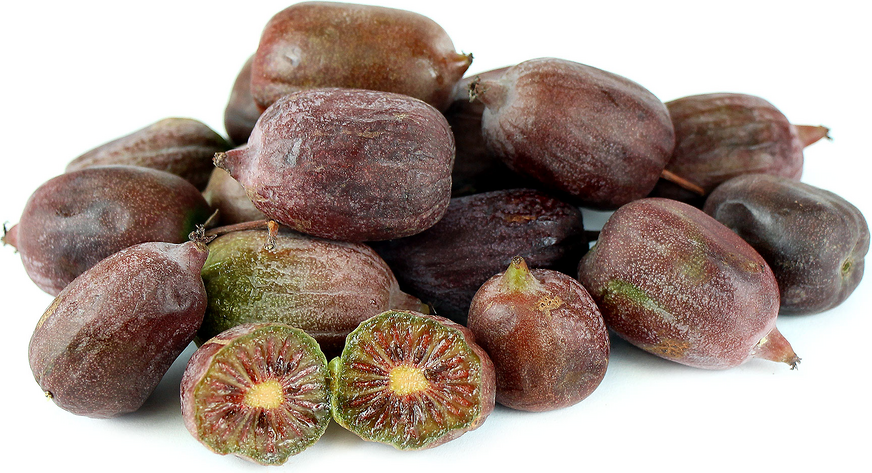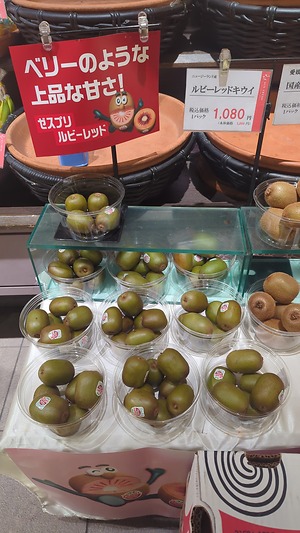


Baby Red Kiwi
Estimated Inventory, bskt : 0
Description/Taste
Baby Red kiwis are small berries that have a similar appearance to grapes. They typically measure 4 to 10 centimeters long and have an ovate torpedo shape that comes to a point at the stem end of the fruit. These fruits have a subtly ridged thin skin that’s absent of the fuzz that larger kiwi varieties possess. Their skin has a maroon-brown hue that’s spotted with giant green dots and is attached to a straight green stem. Baby Red kiwi flesh has a deep ruby-red hue with a succulent and smooth consistency. This tender flesh contains tiny black seeds that are arranged in an oval formation around the inner core of the fruit when sliced length-wise. The entire fruit including the skin of Baby Red kiwis is edible. They have a grape-like fragrance and a sweet and tangy flavor along with a slight crunch from their small seeds.
Seasons/Availability
Baby Red kiwis are available from early to mid-fall.
Current Facts
Baby Red kiwis are botanically classified as Actinidia arguta and belong to the Actinidiaceae family. The Baby kiwi species is also referred to as Hardy kiwi, Dessert kiwi, Grape kiwi, Tara Vine, Bower Vine, Yang-tao, and Kiwi Berries. This species is related to the common kiwi fruit but is smaller and absent of fuzzy skin. Baby kiwis come in a variety of colors including green, brown, purple, and red. These fruits grow on climbing vines that can reach between 6 and 20.5 meters long and often grow upwards on trees or trellises. These plants may be used as ornamentals as they bloom cream-colored flowers with a fragrant aroma. Baby Red kiwis are mainly valued for their culinary uses and are frequently enjoyed as a fresh fruity snack.
Nutritional Value
Baby kiwis offer similar nutritional benefits as the common kiwi. They have a high vitamin C content that supports a strong immune system, aids in collagen production for healthy skin, and helps with the absorption of iron. Vitamin A in Baby kiwis is important for maintaining good vision and supporting the immune system while vitamin E acts as a powerful antioxidant that protects cells from oxidative damage. The presence of riboflavin in these fruits helps the body convert food into energy while also supporting healthy skin, hair, and eyes. Baby kiwis are a source of fiber that aids in digestion, promotes gut health, and helps maintain healthy cholesterol levels.
Applications
Baby Red kiwis are entirely edible including their skin, seeds, and flesh. Their delicate texture is best enjoyed when prepared in fresh or preserved applications. The small size of Baby Red kiwis makes them ideal for eating fresh out of hand or tossing into fruit bowls, yogurt parfaits, smoothies, and salads. They can be cut in half and combined with fresh fruit to serve as a topping for breakfast foods like waffles and pancakes. Their vibrant red hue is ideal for showcasing on fruit tarts. A unique way to serve Baby Red kiwis is by sprinkling them with powdered sugar and folding them into a sweet omelet made with lemon zest and cinnamon. They can also be incorporated into kiwi jams, jellies, and chutneys. This variety pairs well with raspberries, blueberries, strawberries, pineapple, bananas, apples, oranges, melons, whipped cream, honey, mint, coriander, walnuts, chili paste, and sautéed fish. Baby Red kiwis are delicate fruits that can quickly deteriorate after they're harvested. For best quality keep them refrigerated and use within one week.
Ethnic/Cultural Info
Baby kiwis gained popularity among Americans who traveled to the fruit's native regions in Asia. Tourists from the Northeastern United States began bringing back Baby kiwi seeds as these fruits thrived in the cold winters of the region. At this time these fruits were primarily valued for their long vines that could grow up fences, houses, and exterior walls. They were commonly used during the Gilded Age to cover up houses with damaged, old-fashioned, or unsightly facades. It wasn’t until properties were starting to be rebuilt and modernized that people realized Baby kiwis could be used as an edible crop rather than a decorative one.
Geography/History
Baby Red kiwis are hybrids made from breeding traditional Baby kiwis with larger sized red-fleshed kiwis. They were developed by New Zealand horticulturist Ken Nobbs. This variety is frequently sown in cool climates with harsh winters as these fruits are frost tolerant and can withstand temperatures as low as negative 20 degrees Celcius. The Baby kiwi species is native to Central Asia and began spreading internationally after it was brought back by tourists to the Northeastern United States in the late 19th century. Subsequent breeding programs at institutions like the University of New Hampshire and Ohio State University helped further cultivate these fruits and promote their production among local farmers. Baby Red kiwis are a niche fruit that’s most commonly found in their native New Zealand. They are also commercially produced in Europe, Australia, the United States, and the former Soviet Union on a smaller scale where they may be occasionally found at farmers' markets and specialty stores.
Recipe Ideas
Recipes that include Baby Red Kiwi. One
| Go Raw |
|
Red Kiwi Salad |









